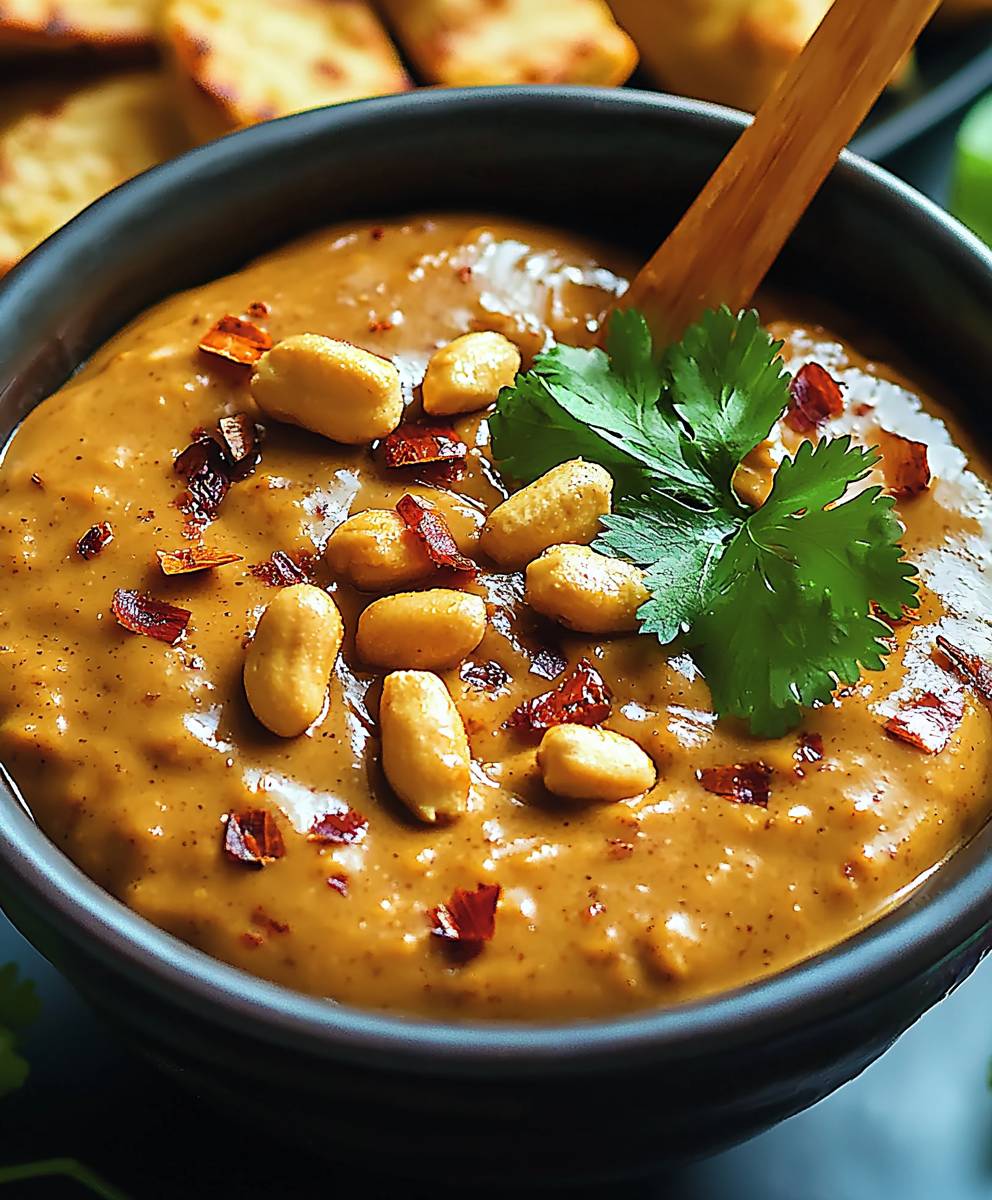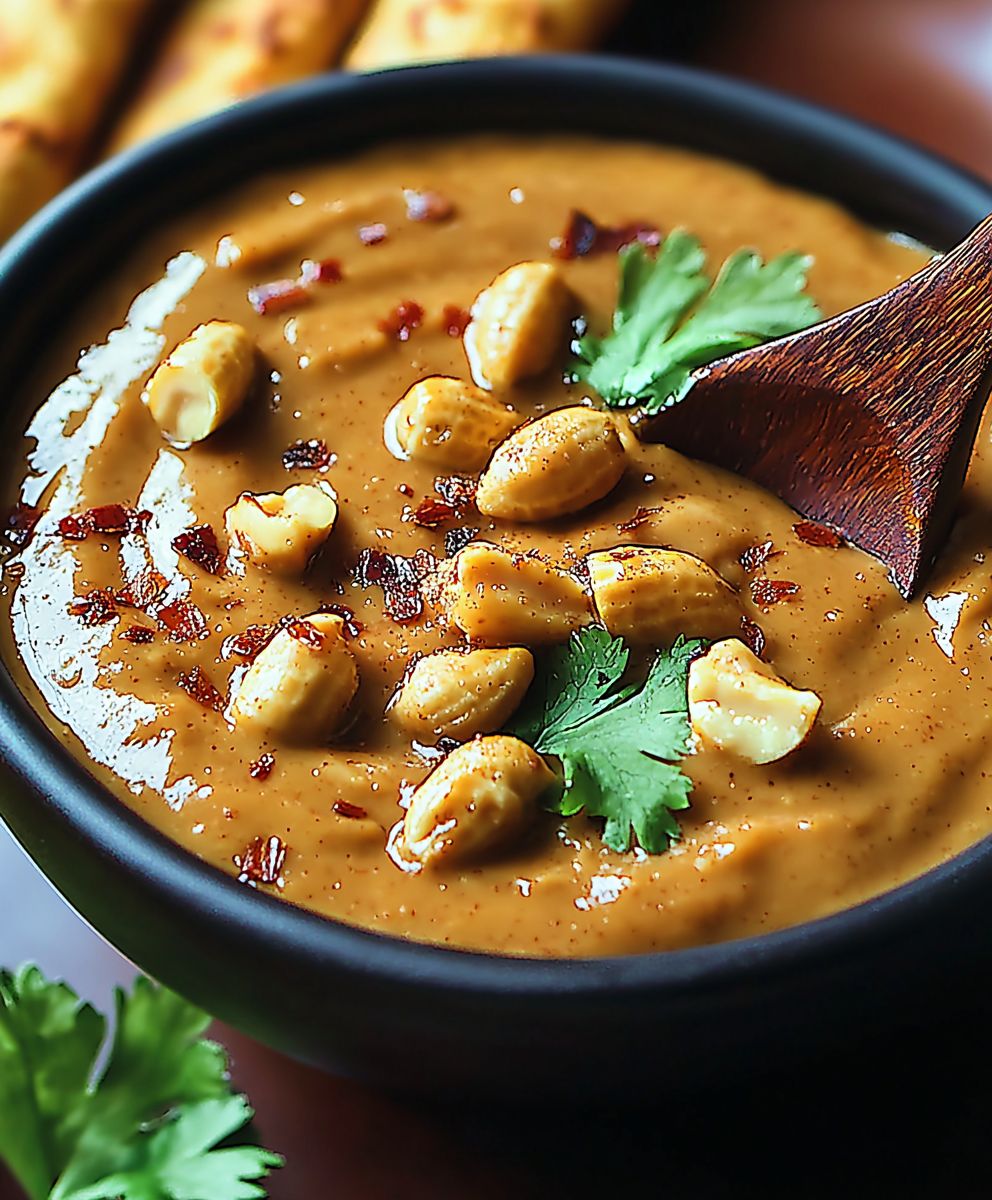Peanut Satay Sauce: Just the name conjures up images of vibrant street food, the tantalizing aroma of grilled meats, and the perfect balance of sweet, savory, and spicy flavors. Have you ever wondered how to recreate that authentic taste at home? Well, you’re in the right place! I’m going to show you how to make a truly incredible peanut satay sauce that will elevate everything from chicken skewers to noodle dishes.
Satay, originating in Indonesia, has become a beloved dish throughout Southeast Asia and beyond. Its roots can be traced back to the Middle East and India, with influences from kebabs brought by Arab and Indian traders. Over time, it evolved into the unique and flavorful dish we know and love today, with peanut satay sauce being the star of the show.
What makes this sauce so irresistible? It’s the symphony of flavors! The creamy richness of peanuts is perfectly balanced by the tang of lime, the sweetness of brown sugar, and the fiery kick of chili. People adore it because it’s incredibly versatile, adding depth and complexity to any dish. Plus, it’s surprisingly easy to make at home, and my recipe ensures you’ll achieve that authentic, restaurant-quality taste every single time. Get ready to impress your friends and family with this amazing sauce!
Ingredients:
- 1 cup (240ml) coconut milk, full-fat preferred
- 1/2 cup (120g) peanut butter, smooth or chunky (I prefer smooth for a creamier sauce)
- 1/4 cup (60ml) soy sauce, low sodium
- 2 tablespoons lime juice, freshly squeezed (about 1 large lime)
- 2 tablespoons brown sugar, packed
- 1 tablespoon rice vinegar
- 1 tablespoon sesame oil
- 1-2 cloves garlic, minced (adjust to your taste)
- 1 teaspoon ginger, freshly grated
- 1/2 teaspoon red pepper flakes (or more, to taste be careful!)
- 1/4 teaspoon ground coriander
- 1/4 teaspoon ground cumin
- Pinch of salt, or to taste
- Water, as needed to thin the sauce
Preparing the Peanut Satay Sauce:
- Combine the Base Ingredients: In a medium saucepan, whisk together the coconut milk, peanut butter, soy sauce, lime juice, brown sugar, rice vinegar, and sesame oil. Make sure the peanut butter is well incorporated into the coconut milk before moving on. This will prevent lumps later.
- Add Aromatics and Spices: Add the minced garlic, grated ginger, red pepper flakes, ground coriander, and ground cumin to the saucepan. Stir well to distribute the spices evenly throughout the mixture. The aroma at this point should be amazing!
- Simmer the Sauce: Place the saucepan over medium heat. Bring the mixture to a gentle simmer, stirring constantly to prevent sticking and burning. Once simmering, reduce the heat to low and continue to simmer for about 5-7 minutes, or until the sauce has thickened slightly. The sauce should coat the back of a spoon.
- Adjust Consistency: If the sauce becomes too thick, add water, one tablespoon at a time, until you reach your desired consistency. Remember that the sauce will thicken slightly as it cools. I usually aim for a consistency that’s easily pourable but still clings nicely to whatever I’m serving it with.
- Taste and Season: This is the most important step! Taste the sauce and adjust the seasoning as needed. You might want to add a pinch more salt, a squeeze more lime juice for extra tang, or a dash more red pepper flakes for extra heat. Don’t be afraid to experiment and make it your own!
- Cool and Store: Remove the saucepan from the heat and let the sauce cool slightly. Once cooled, transfer the sauce to an airtight container and store it in the refrigerator for up to 5 days. The sauce will thicken further as it cools, so you may need to add a little water to thin it out when you’re ready to use it.
Tips and Variations:
- Peanut Butter Choice: While I prefer smooth peanut butter for a super creamy sauce, chunky peanut butter adds a nice textural element. Experiment and see which you like best!
- Spice Level: The 1/2 teaspoon of red pepper flakes provides a mild kick. If you like it spicier, add more red pepper flakes or a pinch of cayenne pepper. Be cautious, though a little goes a long way!
- Sweetness: Adjust the amount of brown sugar to your liking. If you prefer a less sweet sauce, start with 1 tablespoon and add more as needed. You can also substitute honey or maple syrup for the brown sugar.
- Nut Allergy Alternative: If you have a peanut allergy, you can try using sunflower seed butter or tahini as a substitute. The flavor will be different, but it can still be delicious!
- Make it Ahead: This sauce is great for making ahead of time. In fact, the flavors tend to meld together even more as it sits in the refrigerator. Just be sure to give it a good stir before using.
- Grilling Enhancement: Use the peanut satay sauce as a marinade for chicken, beef, or tofu before grilling. The sauce will caramelize beautifully on the grill and create a flavorful crust.
- Vegetable Dip: Serve the sauce as a dip for raw vegetables like carrots, celery, cucumbers, and bell peppers. It’s a healthy and delicious snack!
- Noodle Sauce: Toss the sauce with cooked noodles (rice noodles, egg noodles, or even spaghetti) for a quick and easy meal. Add some chopped vegetables and protein for a complete dish.
- Satay Skewers: Of course, the classic use for peanut satay sauce is with satay skewers! Marinate chicken, beef, or tofu in the sauce, thread them onto skewers, and grill or bake them until cooked through. Serve with extra sauce for dipping.
- Coconut Milk Substitute: While full-fat coconut milk provides the richest flavor and creamiest texture, you can use light coconut milk if you’re looking to reduce the fat content. Just be aware that the sauce may be slightly thinner.
- Lime Juice Alternative: If you don’t have fresh limes, you can use bottled lime juice, but the flavor won’t be quite as bright. In a pinch, you can also substitute lemon juice.
- Ginger Variation: If you don’t have fresh ginger, you can use ground ginger, but the flavor will be less intense. Use about 1/2 teaspoon of ground ginger in place of the 1 teaspoon of fresh ginger.
Serving Suggestions:
Peanut Satay Sauce is incredibly versatile and can be used in a variety of dishes. Here are some of my favorite ways to use it:
- Satay Skewers: The classic pairing! Marinate chicken, beef, or tofu in the sauce, thread them onto skewers, and grill or bake them until cooked through. Serve with extra sauce for dipping and a side of rice.
- Noodle Bowls: Toss cooked noodles (rice noodles, soba noodles, or even spaghetti) with the sauce, chopped vegetables (like bell peppers, carrots, and cucumbers), and your choice of protein (chicken, shrimp, tofu, or tempeh). Garnish with chopped peanuts and cilantro.
- Spring Rolls: Serve the sauce as a dipping sauce for fresh spring rolls filled with rice noodles, vegetables, and shrimp or tofu.
- Lettuce Wraps: Use the sauce as a base for lettuce wraps. Combine ground chicken or tofu with chopped vegetables and the sauce, then spoon the mixture into lettuce cups.
- Grilled Vegetables: Brush the sauce onto grilled vegetables like eggplant, zucchini, and bell peppers for a flavorful and healthy side dish.
- Rice Bowls: Drizzle the sauce over rice bowls filled with your favorite toppings, such as grilled chicken or tofu, steamed vegetables, and a fried egg.
- Pizza Topping: Get creative and use the sauce as a base for a unique pizza topping. Add grilled chicken, vegetables, and mozzarella cheese for a delicious and unexpected flavor combination.
- Salad Dressing: Thin the sauce with a little water or rice vinegar and use it as a dressing for Asian-inspired salads.
- Dumpling Dipping Sauce: Serve the sauce as a dipping sauce for steamed or fried dumplings.
- Sandwich Spread: Use the sauce as a spread for sandwiches or wraps. It pairs well with grilled chicken, vegetables, and avocado.
Nutritional Information (Approximate):
Please note that the nutritional information is an estimate and may vary depending on the specific ingredients used.
- Serving Size: About 2 tablespoons
- Calories: 150-180
- Fat: 12-15g
- Saturated Fat: 6-8g
- Cholesterol: 0mg
- Sodium: 200-250mg
- Carbohydrates: 8-10g
- Fiber: 1-2g
- Sugar: 5-7g
- Protein: 5-7g
Enjoy your homemade Peanut Satay Sauce! I hope you find it as delicious and versatile as I do.

Conclusion:
This isn’t just another sauce recipe; it’s a flavor explosion waiting to happen! I truly believe this Peanut Satay Sauce is a must-try for anyone who loves bold, savory, and slightly sweet flavors. It’s incredibly versatile, surprisingly easy to make, and will elevate your meals from ordinary to extraordinary in a matter of minutes. Forget the store-bought stuff loaded with preservatives and artificial ingredients this homemade version is fresher, tastier, and you control exactly what goes into it.
Think about it: the rich, nutty depth of the peanuts, the tangy zest of lime, the subtle heat of chili, and the aromatic blend of spices all coming together in perfect harmony. It’s a symphony of flavors that will dance on your taste buds! I’ve been making this sauce for years, and it’s always a crowd-pleaser. Whether you’re a seasoned chef or a beginner in the kitchen, you’ll find this recipe straightforward and rewarding.
But the best part? The possibilities are endless! While I personally love serving this Peanut Satay Sauce with grilled chicken skewers and a side of fluffy rice, don’t let that limit your imagination. It’s fantastic as a dipping sauce for spring rolls or vegetable crudités. Drizzle it over noodles for a quick and satisfying lunch. Use it as a marinade for tofu or tempeh before grilling or baking. Or, get really creative and add a dollop to your favorite burger for an unexpected twist.
Here are a few serving suggestions and variations to get you started:
* For a spicier kick: Add a pinch of cayenne pepper or a few extra chili flakes to the sauce.
* For a sweeter flavor: Increase the amount of honey or brown sugar.
* For a creamier texture: Add a tablespoon or two of coconut milk.
* For a vegan option: Ensure your honey is plant-based or substitute it with maple syrup or agave nectar.
* Serving suggestion: Toss it with cold noodles, shredded carrots, cucumbers, and edamame for a refreshing summer salad.
* Serving suggestion: Use it as a dipping sauce for chicken satay, vegetable skewers, or even crispy tofu.
* Serving suggestion: Drizzle it over a grilled chicken or shrimp bowl with rice and your favorite veggies.
I’m so confident that you’ll love this recipe that I urge you to give it a try. It’s a game-changer, I promise! Once you’ve made your own batch of this incredible Peanut Satay Sauce, I’d love to hear about your experience. Did you try any variations? What did you serve it with? Share your photos and stories in the comments below! I’m always looking for new and exciting ways to use this versatile sauce. Don’t be shy let me know what you think! Happy cooking! I can’t wait to see what culinary masterpieces you create with this recipe. Remember, the kitchen is your playground, so have fun and experiment! This sauce is a fantastic base to build upon, so don’t be afraid to make it your own. Enjoy!
Peanut Satay Sauce: The Ultimate Guide to Making It at Home
Creamy, flavorful peanut satay sauce perfect for dipping, marinating, or drizzling. Easy to make and customizable to your spice preference!
Ingredients
- 1 cup (240ml) coconut milk, full-fat preferred
- 1/2 cup (120g) peanut butter, smooth or chunky
- 1/4 cup (60ml) soy sauce, low sodium
- 2 tablespoons lime juice, freshly squeezed
- 2 tablespoons brown sugar, packed
- 1 tablespoon rice vinegar
- 1 tablespoon sesame oil
- 1-2 cloves garlic, minced
- 1 teaspoon ginger, freshly grated
- 1/2 teaspoon red pepper flakes
- 1/4 teaspoon ground coriander
- 1/4 teaspoon ground cumin
- Pinch of salt, or to taste
- Water, as needed to thin the sauce
Instructions
- Combine the Base Ingredients: In a medium saucepan, whisk together the coconut milk, peanut butter, soy sauce, lime juice, brown sugar, rice vinegar, and sesame oil. Ensure the peanut butter is well incorporated.
- Add Aromatics and Spices: Add the minced garlic, grated ginger, red pepper flakes, ground coriander, and ground cumin to the saucepan. Stir well.
- Simmer the Sauce: Place the saucepan over medium heat. Bring the mixture to a gentle simmer, stirring constantly. Reduce the heat to low and continue to simmer for about 5-7 minutes, or until the sauce has thickened slightly.
- Adjust Consistency: If the sauce becomes too thick, add water, one tablespoon at a time, until you reach your desired consistency.
- Taste and Season: Taste the sauce and adjust the seasoning as needed. Add more salt, lime juice, or red pepper flakes to your preference.
- Cool and Store: Remove the saucepan from the heat and let the sauce cool slightly. Transfer the sauce to an airtight container and store it in the refrigerator for up to 5 days.
Notes
- Peanut Butter Choice: Smooth peanut butter is recommended for a creamier sauce, but chunky can be used for added texture.
- Spice Level: Adjust the amount of red pepper flakes to your preference.
- Sweetness: Adjust the amount of brown sugar to your liking. Honey or maple syrup can be substituted.
- Nut Allergy Alternative: Sunflower seed butter or tahini can be used as a substitute for peanut butter.
- Make it Ahead: This sauce is great for making ahead of time.
- Grilling Enhancement: Use the peanut satay sauce as a marinade for chicken, beef, or tofu before grilling.
- Vegetable Dip: Serve the sauce as a dip for raw vegetables.
- Noodle Sauce: Toss the sauce with cooked noodles for a quick and easy meal.
- Satay Skewers: Marinate chicken, beef, or tofu in the sauce, thread them onto skewers, and grill or bake them until cooked through.
- Coconut Milk Substitute: Light coconut milk can be used if you’re looking to reduce the fat content.
- Lime Juice Alternative: Bottled lime juice can be used, but the flavor won’t be quite as bright.
- Ginger Variation: If you don’t have fresh ginger, you can use ground ginger, but the flavor will be less intense.






Leave a Comment